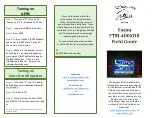
ATBC 0
disables BCL, and thus the modem will transmit whenever it has data
to send out. The factory-default is BCL disabled. Use caution when enabling
it, as a CW interferer, PC with poor shielding, or some other source of RF can
stop the modem from transmitting. The threshold where the FireLine senses
RF carrier, and determines that the channel is busy is set by the
ATRA
command. This is factory calibrated to an equivalent RF level of
approximately -110dBm.
4.4.
Data Reception
When the modem receives data over the radio, it checks it for errors, and if it
is error-free, it will send it out the serial port. Again, the serial port may be set
to any baud rate the user wishes, and the radio receiver and transmitter will
continue to operate independently of the baud rate.
When the modem receives a signal, it will assert the CD hardware signal on
the RS-232 serial port if it was configured to do so.
In general, the slower the over-the-air data rate, the easier it is for the modem
to receive the signal, and thus the more communication range the radio will
have. FireLine modems have a unique switched-filter along with digital signal
processing, that gives them more range a lower data rates. See Section 6.9
Setting the Over-The-Air Data Rate for more information about choosing the
over-the-air data rate.
4.5.
Addressing (Packetized Mode only)
Addressing Basics
One of the more powerful aspects of the
FireLine
modem is its addressing
scheme. Incorporating addressing in the modem allows multiple radio
systems on the same frequency to co-exist, and not interfere with each other.
Also, some user application cannot tolerate receiving data that was not
intended for it, and by setting the addresses in the modems properly, the
system can be configured to allow reception of only data intended for the
recipient.
If addressing is not needed or desired, it can be turned off so that all modems
receive data from all other modems, and all modems can talk to all other
modems.
Each
FireLine
contains a 16 bit address, called its Unit Address, and is
represented as a 4 digit hexadecimal number.
FireLine
address may be any
number between 0000 and FFFF, which is effectively 65,535 different
addresses. Every
FireLine
has a Unit Address programmed into it, as well as
the ID of the unit it will send data to. The Unit Address is programmed with
the
ATMY xxxx
command, and the Unit Address of the destination modem
(the Destination Address) is configured with the
ATDT xxxx
command.
The defaults UNIT ID in al
FireLine
modems is 1234, and 1234 is the default
for the destination ID. An Address Mask is used to select which digits of the
address will be used to determine if a particular reception was intended for
















































